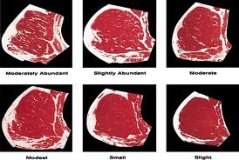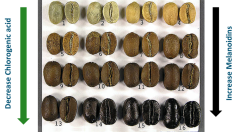Onderwerp scriptie
Quality design of foods: From product to chain design
Topic 1. Quality parameters influencing consumers’ perceptions of canned tomato products.
Tomatoes in cans are commonly used in all kinds of food recipes. On the shelves, the canned tomatoes might seem for consumers very similar but large differences in quality parameters exist among peeled tomatoes, chopped tomatoes, cherry tomatoes, tomato puree, tomato sauces. The different types of canned products have different cost, taste, destination of use, however, many consumers are not aware of this.
The research focus is on consumers’ perceptions of canned tomatoes: 1. What do consumers perceive as quality determinants regarding this food product? 2. How are these quality parameters influenced by the consumers’ knowledge about this food product? The gained insights in consumers’ perceptions would be used to analyse opportunities for creating added value to the existing products and communicating properly their quality. The research aims to identify those key quality parameters that could be changed based upon consumers’ perceptions.
The research approach is in this thesis would be first a literature review on the known quality parameters of canned tomatoes. Subsequently, a consumer survey and/or consumer interviews and/or sensory tests could be done to gain insights into the perceived quality of a selected number of canned tomatoes. Finally, the analysis of key parameters should be translated into product changes.
Consumer panels/focus group discussions might be used to verify the perception of the quality of these ‘optimised’ products by different categories of consumers.
For more information on this topic please contact Vincenzo Fogliano.
Topic 2. Quality design of functional pasta to increase market share.
Vegetables can contribute to a healthy diet, but the intake is for various consumers still limited. The food industry is searching for innovative products containing vegetable ingredients that are tasty and healthy. Pasta enriched with vegetables can be a good strategy to increase the vegetables intake, because (1) pasta is routinely consumed, and (2) dry pasta is a perfect carrier to stabilise phytochemicals that otherwise are easily degraded.
Currently some vegetables containing pasta products (mainly spinach ) are available at the market but they are purchased just one time or ad hoc and repeated purchase is limited. The main research question is what are the key factors contributing to repeated purchase for this type of products?
Typical sub-research questions are: What are consumer expectations and perceptions of “coloured pasta” that contain vegetable ingredients? Which steps need to be undertaken along the pasta supply chain to allow this functional pasta to exit from the niche market and become a regular choice?
The research will consist of a literature review on quality parameters of vegetable pasta. Interviews with consumers could be done to gain insight into current pasta use and expected quality attributes of vegetable pasta in order to implement them in product design.
The case study of broccoli pasta will be the starting point to define a general strategy that could be used in product design and in the definition of key messages to consumers. More details will be provided next year.
For more information on this topic please contact Vincenzo Fogliano.
Topic 3. Crucial correlations between product and process variables in processing pre-cooked rice.
Dry rice sold at retailers usually has a moisture content of appr. 12% or lower. This moisture level prevents micro-organisms to grow on rice, which makes the product shelf stable for a long time at ambient conditions. When rice is sold as pre-cooked rice, dry rice will have to be cooked, filled and subsequently processed in flexible packaging materials (e.g. pouches) to deliver an ambient shelf-stable product for consumers. Any micro-organisms present in the pack will need to be inactivated to guarantee food product sterility. Inactivation of these micro-organisms is depending on a number of factors like time, temperature, pH but also Aw (related to moisture content) of the food product. Key in this master thesis is to gain insight in the crucial correlations between all the involved factors and particularly the role of Aw/hydration in the inactivation of micro-organisms. Therefore, the overall research question is: “What is known about the crucial correlations between time, temperature (processing conditions) and Aw/hydration and pH (food dynamics) and particularly the role of Aw/hydration in the inactivation of micro-organisms i.e. spores on pre-cooked (dry/hydrated) rice?”
The literature review on factors determining the inactivation of micro-organisms in rice has two aims:
1. To identify implications for HACCP systems of rice supply chains to guarantee an ambient shelf-stable product for consumers
2. To identify implications for consumers’ use of rice products at home to guarantee their health
The research approach in this master thesis is majorly literature review combined with consultations of rice supply chains and consumers depending of the literature findings. Finally, the deliverables of this thesis should be an advance in understanding on the possible contamination routes of the relevant micro-organisms along rice supply chains, the inactivation factors at factories, the CCP’s along rice supply chains and the consumers’ role in this respect.
For more information on this topic please contact Vincenzo Fogliano.
Topic 4. Constructing ‘Critical Quality Points’ frameworks on quality designing of new product.
New Product Development (NPD) is of crucial for food industry in maintaining consumers buying their brands. NPD can be technological-driven or consumer-driven. In both kinds of NPD, it is necessary to understand the critical quality points of the new product development processes. Since understanding of the critical quality points of NPD processes may enhance the success rates of those innovations involved. Critical quality points of NPD processes are, for instance, adequate communication between departments or clear product specifications. The critical quality points of NPD processes can be distinguished into three categories: (a) the food product, (b) the food processing, and (c) the food packaging. The aim of the master thesis is to clarify the critical quality points of NPD processes in order to optimize these processes in the food industry in term of innovation success and process efficiency. The clarification of critical quality points will be done via literature review and experts consultations across the academia and food industry. The consultation of the academia and the food industry will be purposefully conducted to increase the added value of the framework for scientific purposes as well as for business purposes. One of the task is to validate an existing framework on quality designing of new product development processes on its usefulness for a particular part of the food industry, for instance dairy industry or beverage industry. Another task is to research the feasibility of applying the lean thinking framework in order to gain in efficiency of new product development processes in food industry.
For more information on this topic please contact Elsbeth Spelt.
Topic 5. Importance of factors determining fresh meat quality.
Meat is one of the sources of food having a high nutritional value. As for each food product a high quality is important for consumers. The major components determining of high meat quality are:1. Yield and gross composition
- Quantity of saleable product
- Ratio of fat to lean
- Muscle size and shape
2. Appearance and technological characters
- Fat texture and colour
- Amount of marbling in lean (intramuscular fat)
- Chemical composition of lean
- Colour and WHC of lean
3. Palatability
- Texture and tenderness
- Juiciness
- Flavour
4. Wholesomeness
- Nutritional quality
- Chemical safety
- Microbiological safety
5. Ethical quality
- Acceptable husbandry of animals

For more information on this topic please contact Jozef Linssen.
Topic 6. Food design strategies to add value to the coffee chain.
The Coffee production is still of major importance in the trade between transition countries producing the raw beans and developed countries where most of the roasting and consumption occur. There is a continuous effort to create new business opportunity around coffee with the development of new products such as the coffee capsules for domestic consumption. Roasting and processing of coffee also offer opportunities for differentiate the products and different chemical composition can also lead to different food and health implicationResearch questions
Question 1: Can dry separation technology be applied to obtain different coffee products?Question 2: Can the addition of precursor during wetting influence the formation of melanoidins keeping the same roasting degree ? Are the aroma key odorants influenced by this practice?
Question 3: Which are the key determinant of quality perceived by consumer and how this is related to previous consumption experience (i.e origin country)
Proposed approach
To answer the different research question appropriate methodologies will be used combining chemical and physical analysis with formulation strategies and new processing technique. Focus group and consumer survey will be employed to answer question 3References
Illy, A., & Viani, R. (1995). Espresso Coffee. The Chemistry of Quality; Academic Press Ed, London.Vitaglione, P; Fogliano, V; Pellegrini, N. Coffee, colon function and colorectal cancer, Food and Function 2012, 3, 916-922
Fogliano V, Morales MJ. Estimation of dietary intake of melanoidins from coffee and bread. Food and Function 2011, 2, 117-123

For more information on this topic please contact Vincenzo Fogliano.